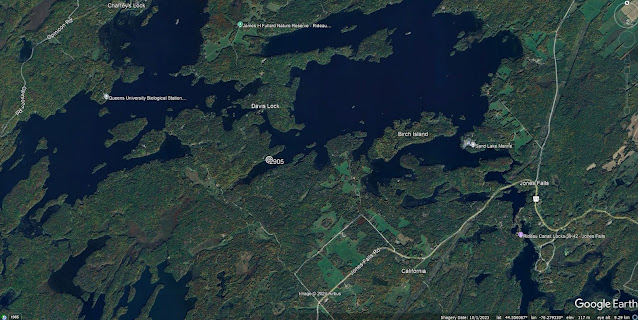 |
#2905 "Sunrise on Sand Lake"
14 X 11 inches oils on canvas.
Elliot Bay of Sand Lake looking toward the northeast
at sunrise from very near N44.556058° W76.289842°
|
The sun was only about ten minutes above the northeastern horizon on the opening day of bass season. The streets of stratocumulus were backlit and thus darker in their middle. Only the dark sides of the more distant clouds were visible while the undersides of the overhead stratocumulus were still catching the sun's rays. Those cloud bottoms were white due to Mie scattering of the radiation in a forward direction from the large cloud droplets.
The sky's deep blue was a product of Rayleigh scattering from atmospheric molecules. Short wavelengths of blue light are preferentially cast in all directions.
The shorelines became increasingly pale with distance as the scattering of light from dust in the lowest levels of the atmospheric ocean added white to the mix of colours that the eyes witnessed.
The overhead patch of cirrocumulus in the upper left corner was illuminated from the bottom. That patch of cloud was essential to complete the weather story.
Given the fetch and the geography of Sand Lake, the light breeze had to be associated with the easterly flow of a cold conveyor belt. The thin patch of cirrocumulus was the only indication that a low-pressure system was generating gentle lift in the upper atmosphere. The next weather system was approaching from the southwest. That system was still a long way off, so there were no immediate concerns although the dark stratocumulus can look ominous!
The following graphic explains how the speed of the system approach can match the wind in the cold conveyor belt resulting in a "calm before the storm" experience with nil wind at the surface.
 |
If the system speed is a bit slower or the cold conveyor belt stronger associated with a
more vigorous weather development, the observed wind at the surface would be easterly as
witnessed on June 15, 2024, at 5:44am in Elliot Bay, Sand Lake. Weather was on the way! |
Note that the surface winds are backed by about 30 degrees from the orientation of the stratocumulus streets because of friction at the surface (see "Meteorology Meets Oceanography" for the story of the Ekman Spiral)
 |
The viewing location for #2905 "Sunrise on Sand Lake" is in the centre of the above map.
Most of my work has been located using GPS technology. |
The cirrocumulus was associated with the leading edge of the warm conveyor belt (WCB in the above graphic).
Together the clouds told the story of a departing high-pressure area and the approach of a low. All of the clues in the sky are consistent with the puzzle pieces of the conceptual model That is weather as it should be and it keeps life interesting. The conveyor belt conceptual model of disturbances within the atmospheric ocean is a great place to start exploring the sky and reading the clues in the clouds.
The white pines stretched into the sky. The sun glinted off the rippled lake creating a golden path to follow in search of the elusive 6-pound bass. Light reflection prevails at those glancing angles otherwise water refracts
more energy than it scatters.
The only hints of cottages were the sparkles of light reflected from the shoreline docks. That is Fahey Island to the right of the sun.
The day would be a beauty surrounded by nature, regardless of whether one caught any fish. Of course, none of the science described is required to enjoy a day on the water. I enjoy reading the sky stories and becoming closer to the weather. Sharing this science and those details just helps to make the story behind a painting more complete.
There is a familiar saying:
"When the wind is in the east, then the fishes bite the least; When the wind is in the west, then the fishes bite the best."
The truth behind this ditty can be found in science. The higher atmospheric pressure of the departing high can influence the air in a fish's swim bladder, making it feel less interested in taking any bait that might be offered. Those east winds also bring cooler temperatures, which affect the hatch of aquatic insects, which in turn determines fish activity. Finally, fish generally avoid bright sunshine and tend to stay in the depths rather than rise to a surface lure.
The fishing was likely to be unproductive on the morning of opening day. The bass would be more likely to bite later in the day with the arrival of lower atmospheric pressure, milder temperatures and the cloud cover of the warm conveyor belt.
This was a painting for a dear friend. I picked up the brushes again after a very unusual autumn. I had not painted since the International Plein Air Painters (IPAP) WORLDWIDE Paint Out in early September. I really missed it! The tunes and wood stove were making some very merry music inside the Singleton Studio. I do not know if my friend caught any fish...
For this and much more art, click on Pixels or go straight to the Collections. Here is the new Wet Paint 2024 Collection.
Warmest regards and keep your paddle in the water,
Phil Chadwick




















